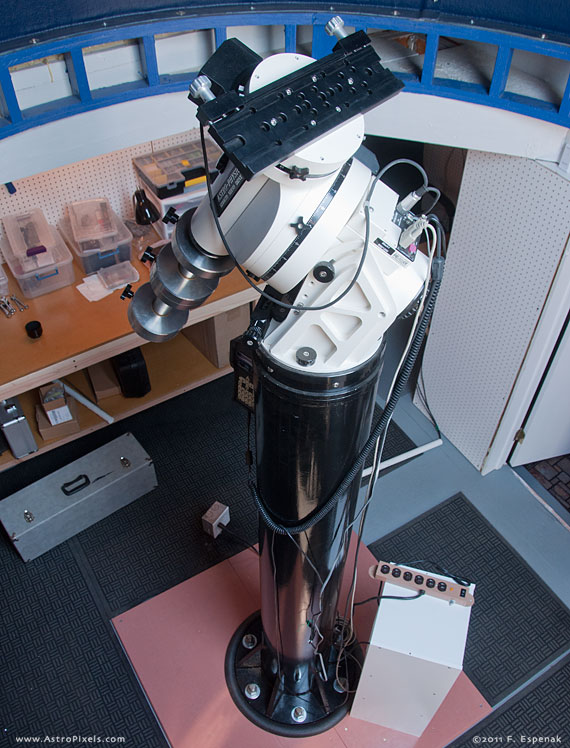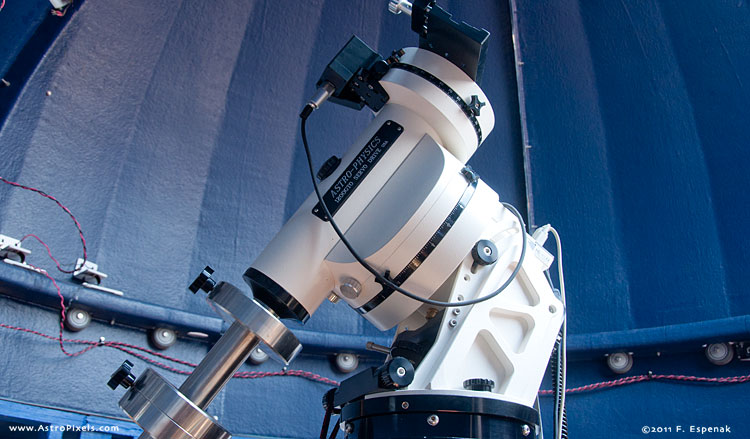Long before construction began on Bifrost Astronomical Observatory, I needed to choose between several excellent equatorial mounts that were within my budget. It's often said that a telescope is only as good as the equatorial mount that supports it. An equatorial mount must be able to support the weight of the telescope along with all the ancillary equipment (eyepieces, diagnals, finderscopes, autoguiders, CCD cameras, etc.) in every conceivable orientation as the telescope tracks objects across the sky. And it must do this without introducing or transmitting any significant vibration. The equatorial mount must also be extremely precise in its design and construction so that it is able to track across the sky at a constant rate with no wobbles or errors.
I've always been a fan of the German Equatorial Mount (GEM) although there are a number of other types of equatorial mounts commercially available. The GEM can point to any part of the sky and can hold a relatively heavy load provided that its balanced by counterweights. I considered Software Bisque's Paramount, but the Astro-Physics 1200GTO seemed better suited to my needs. The fact that I already own two AP refractors (AP105 and AP130) played a role. And two of my ASV neighbors have observatories equipped with AP 1200GTO mounts and they were both producing some impressive images with them. Finally, the AP 1200GTO is one of the few mounts that does't have problems tracking across the meridian.
In the past, you had to get on a several-year waiting list to order an AP 1200GTO. Astro-Physics has ramped up their production on the 1200GTO so there's rarely more that a couple month wait. My AP 1200GTO was delivered in the spring of 2009 in the midst of construction of Bifrost Observatory. So the AP 1200GTO sat in the garage in it's crate for six months until I was ready for it.

By December 2009, the interior work on the observatory was complete so I uncrated the AP 1200GTO and mounted it atop the 6-foot steel pier in the observatory. Unfortunately, the hole placement on the adapter plate wouldn't allow me to polar align the mount. Jim Algots and his machine shop came to the rescue as we drilled new holes in the adapter plate. First Light in the new observatory took place on the evening of Jan. 1, 2010.
I've now been using the AP 1200GTO for over a year and it has performed beyond my expectations. The tracking is so accurate, that autoguiding isn't even needed on short exposures.
Below is a table of the technical specifications on the AP 1200GTO. For more information, see Astro-Physics web site.
| Astro-Physics 1200GTO Equatorial Head Specifications (2010) | |
|---|---|
| R.A. worm wheel | 10.3" (26.2cm), 225 tooth aluminum |
| Declination worm wheel | 7.2" (18.3cm), 225 tooth aluminum |
| Worm gears | Brass |
| R.A. shaft | 3.35" (8.5cm) diameter |
| R.A. thrust bearings | 9.5" (24.1cm) diameter |
| Dec. shaft | 2.36" (6.0cm) diameter |
| Dec. thrust bearings | 6.5" (16.5cm) diameter |
| Latitude range | 22 to 69 degrees |
| Azimuth adjustment | Approximately 14 degrees |
| Setting circles | Porter Slip Ring design, engraved, pointer |
| Right ascension | 4-minute increments, pointer, engraved both Northern/Southern |
| Declination | 1 degree increments, engraved, pointer |
| Capacity | Approximately 140 lb. (63.6kg) scope and accessories.
Will accommodate Astro-Physics and similar refractors up to 206mm f8, 16" Cassegrains and Ritchey-Chretiens, 17" CDK |
| Weight | Equatorial head: 81 lbs. (36.7 kg),
Dec axis 31 lbs. (14.1kg), RA axis 50 lbs. (22.7kg) Counterweight shaft: 14 lbs. (6.4kg) |
